A Novel Mine-Specific Eco-Environment Index (MSEEI) for Mine Ecological Environment Monitoring Using Landsat Imagery
Abstract
1. Introduction
2. Materials and Methods
2.1. Study Area
2.2. Materials
2.3. Mine-Specific Eco-Environment Index (MSEEI)
2.4. Validating the MSEEI
2.5. Kernel Density Analysis and Fractal Dimension Statistics
3. Results
3.1. MSEEI Performance Validation
3.2. Ecological Status of Mining Areas
3.3. Ecological Changes in Mining Areas
4. Discussion
4.1. MSEEI Provides an Effective Method for Assessing Mine Environments
4.2. MSEEI Change Patterns around the Ore Points
4.3. Future Perspectives
5. Conclusions
Author Contributions
Funding
Data Availability Statement
Conflicts of Interest
References
- Li, M.S. Ecological restoration of mineland with particular reference to the metalliferous mine wasteland in China: A review of research and practice. Sci Total Environ. 2006, 357, 38–53. [Google Scholar] [CrossRef] [PubMed]
- Miao, Z.; Marrs, R. Ecological restoration and land reclamation in open-cast mines in Shanxi Province, China. J. Environ. Manag. 2000, 59, 205–215. [Google Scholar] [CrossRef]
- Quanyuan, W.; Jiewu, P.; Shanzhong, Q.; Yiping, L.; Congcong, H.; Tingxiang, L.; Limei, H. Impacts of coal mining subsidence on the surface landscape in Longkou city, Shandong Province of China. Environ. Earth Sci. 2009, 59, 783–791. [Google Scholar] [CrossRef]
- Tripathi, N.; Singh, R.S. Ecological restoration of mined-out areas of dry tropical environment, India. Environ. Monit Assess 2008, 146, 325–337. [Google Scholar] [CrossRef]
- Xiao, W.; Zhang, W.; Ye, Y.; Lv, X.; Yang, W. Is underground coal mining causing land degradation and significantly damaging ecosystems in semi-arid areas? A study from an Ecological Capital perspective. Land Degrad. Dev. 2020, 31, 1969–1989. [Google Scholar] [CrossRef]
- Zhang, M.; Wang, J.; Li, S. Tempo-spatial changes and main anthropogenic influence factors of vegetation fractional coverage in a large-scale opencast coal mine area from 1992 to 2015. J. Clean. Prod. 2019, 232, 940–952. [Google Scholar] [CrossRef]
- Chaka, D.S.; Oda, T.K. Understanding land surface temperature on rift areas to examine the spatial variation of urban heat island: The case of Hawassa, southern Ethiopia. GeoJournal 2019, 86, 993–1014. [Google Scholar] [CrossRef]
- Guan, Y.; Wang, J.; Zhou, W.; Bai, Z.; Cao, Y. Identification of land reclamation stages based on succession characteristics of rehabilitated vegetation in the Pingshuo opencast coal mine. J. Environ. Manag. 2022, 305, 114352. [Google Scholar] [CrossRef]
- Ma, C.; Guo, Z.-z.; Zhang, X.-k.; Han, R.-m. Annual integral changes of time serial NDVI in mining subsidence area. Trans. Nonferrous Met. Soc. China 2011, 21, s583–s588. [Google Scholar] [CrossRef]
- Przeździecki, K.; Zawadzki, J.J. Triangle method modification with second degree polynomial edges fitting in LST NDVI scatterplot in lignite mine influence area. Remote Sens. Appl. Soc. Environ. 2020, 20, 100404. [Google Scholar] [CrossRef]
- Thakur, T.K.; Dutta, J.; Upadhyay, P.; Patel, D.K.; Thakur, A.; Kumar, M.; Kumar, A. Assessment of land degradation and restoration in coal mines of central India: A time series analysis. Ecol. Eng. 2022, 175, 106493. [Google Scholar] [CrossRef]
- Zhang, B.; Wu, D.; Zhang, L.; Jiao, Q.; Li, Q. Application of hyperspectral remote sensing for environment monitoring in mining areas. Environ. Earth Sci. 2011, 65, 649–658. [Google Scholar] [CrossRef]
- MORAIN, S.A. Commercialization of remote-sensing technology. Int. J. Remote Sens. 2016, 6, 837–846. [Google Scholar] [CrossRef]
- Airiken, M.; Zhang, F.; Chan, N.W.; Kung, H.T. Assessment of spatial and temporal ecological environment quality under land use change of urban agglomeration in the North Slope of Tianshan, China. Environ. Sci. Pollut. Res. Int. 2022, 29, 12282–12299. [Google Scholar] [CrossRef]
- Hang, X.; Li, Y.; Luo, X.; Xu, M.; Han, X. Assessing the Ecological Quality of Nanjing during Its Urbanization Process by Using Satellite, Meteorological, and Socioeconomic Data. J. Meteorol. Res. 2020, 34, 280–293. [Google Scholar] [CrossRef]
- Hu, X.; Xu, H. A new remote sensing index for assessing the spatial heterogeneity in urban ecological quality: A case from Fuzhou City, China. Ecol. Indic. 2018, 89, 11–21. [Google Scholar] [CrossRef]
- Jiang, F.; Zhang, Y.; Li, J.; Sun, Z. Research on remote sensing ecological environmental assessment method optimized by regional scale. Environ. Sci. Pollut. Res. Int. 2021, 28, 68174–68187. [Google Scholar] [CrossRef]
- Jing, Y.; Zhang, F.; He, Y.; Kung, H.-t.; Johnson, V.C.; Arikena, M. Assessment of spatial and temporal variation of ecological environment quality in Ebinur Lake Wetland National Nature Reserve, Xinjiang, China. Ecol. Indic. 2020, 110, 105874. [Google Scholar] [CrossRef]
- Liu, H.; Jiang, Y.; Misa, R.; Gao, J.; Xia, M.; Preusse, A.; Sroka, A.; Jiang, Y. Ecological environment changes of mining areas around Nansi lake with remote sensing monitoring. Environ. Sci. Pollut. Res. Int. 2021, 28, 44152–44164. [Google Scholar] [CrossRef]
- Liu, Q.; Yang, Z.; Han, F.; Shi, H.; Wang, Z.; Chen, X. Ecological Environment Assessment in World Natural Heritage Site Based on Remote-Sensing Data. A Case Study from the Bayinbuluke. Sustainability 2019, 11, 6385. [Google Scholar] [CrossRef]
- Maity, S.; Das, S.; Pattanayak, J.M.; Bera, B.; Shit, P.K. Assessment of ecological environment quality in Kolkata urban agglomeration, India. Urban Ecosyst. 2022, 25, 1137–1154. [Google Scholar] [CrossRef]
- Ning, L.; Jiayao, W.; Fen, Q. The improvement of ecological environment index model RSEI. Arab. J. Geosci. 2020, 13, 403. [Google Scholar] [CrossRef]
- Qureshi, S.; Alavipanah, S.K.; Konyushkova, M.; Mijani, N.; Fathololomi, S.; Firozjaei, M.K.; Homaee, M.; Hamzeh, S.; Kakroodi, A.A. A Remotely Sensed Assessment of Surface Ecological Change over the Gomishan Wetland, Iran. Remote Sens. 2020, 12, 2989. [Google Scholar] [CrossRef]
- Xu, H.; Wang, Y.; Guan, H.; Shi, T.; Hu, X. Detecting Ecological Changes with a Remote Sensing Based Ecological Index (RSEI) Produced Time Series and Change Vector Analysis. Remote Sens. 2019, 11, 2345. [Google Scholar] [CrossRef]
- Wingate, V.; Phinn, S.; Kuhn, N.; Bloemertz, L.; Dhanjal-Adams, K. Mapping Decadal Land Cover Changes in the Woodlands of North Eastern Namibia from 1975 to 2014 Using the Landsat Satellite Archived Data. Remote Sens. 2016, 8, 681. [Google Scholar] [CrossRef]
- Gallay, M.; Mora, A.; Martinez, J.-M.; Gardel, A.; Laraque, A.; Sarrazin, M.; Beaucher, E.; Doudou, J.-C.; Lagane, C. Dynamics and fluxes of organic carbon and nitrogen in two Guiana Shield river basins impacted by deforestation and mining activities. Hydrol. Process. 2018, 32, 17–29. [Google Scholar] [CrossRef]
- Katpatal, Y.B.; Patil, S.A. Spatial analysis on impacts of mining activities leading to flood disaster in the Erai watershed, India. J. Flood Risk Manag. 2010, 3, 80–87. [Google Scholar] [CrossRef]
- Wei, X.Q.; Gu, X.F.; Meng, Q.Y.; Yu, T.; Jia, K.; Zhan, Y.L.; Wang, C.M. Cross-Comparative Analysis of GF-1 Wide Field View and Landsat-7 Enhanced Thematic Mapper Plus Data. J. Appl. Spectrosc. 2017, 84, 829–836. [Google Scholar] [CrossRef]
- Yan, X.; Qiao, X.; Yang, S.; Feng, M.; Song, X.; Zhang, M.; Xiao, L.; Zhang, Z.; Shafiq, F.; Yang, W.; et al. Hyperspectral response and monitoring study of soil moisture content based on the optimized spectral index. Soil Sci. Soc. Am. J. 2022. [Google Scholar] [CrossRef]
- Xu, S.; Miao, Y.; Li, Y.; Zhou, Y.; Ma, X.; He, Z.; Zhao, B.; Wang, S. What Factors Drive Air Pollutants in China? An Analysis from the Perspective of Regional Difference Using a Combined Method of Production Decomposition Analysis and Logarithmic Mean Divisia Index. Sustainability 2019, 11, 4650. [Google Scholar] [CrossRef]
- Rousta, I.; Olafsson, H.; Nasserzadeh, M.H.; Zhang, H.; Krzyszczak, J.; Baranowski, P. Dynamics of Daytime Land Surface Temperature (LST) Variabilities in the Middle East Countries During 2001–2018. Pure Appl. Geophys. 2021, 178, 2357–2377. [Google Scholar] [CrossRef]
- Qu, Y.; Chi, Y.; Gao, J.; Ma, X.; Wang, Y.P. Distinguishing the determinative landscape factors influencing the spatial variation of soil quality in Chongming Island, China. J. Coast. Conserv. 2022, 26, 42. [Google Scholar] [CrossRef]
- Gou, R.; Zhao, J. Eco-Environmental Quality Monitoring in Beijing, China, Using an RSEI-Based Approach Combined With Random Forest Algorithms. IEEE Access 2020, 8, 196657–196666. [Google Scholar] [CrossRef]
- Xie, S.; Jin, F.; Krishnan, S.; Sattar, F. Signal feature extraction by multi-scale PCA and its application to respiratory sound classification. Med. Biol. Eng. Comput. 2012, 50, 759–768. [Google Scholar] [CrossRef]
- Falco, C.M.; Jiang, X.; Li, Y.; Chen, H.-L.; Song, B.-W.; Zhu, P.-L.; Zhang, H.-W. Vegetation pixels extraction based on red-band enhanced normalized difference vegetation index. In Proceedings of the Eighth International Conference on Digital Image Processing (ICDIP 2016), Chengdu, China, 20–23 May 2016. [Google Scholar]
- Zhao, H.; Li, Y.; Chen, X.; Wang, H.; Yao, N.; Liu, F. Monitoring monthly soil moisture conditions in China with temperature vegetation dryness indexes based on an enhanced vegetation index and normalized difference vegetation index. Theor. Appl. Climatol. 2020, 143, 159–176. [Google Scholar] [CrossRef]
- Arekhi, M. Investigating Land Surface Temperature (LST) Change Using the LST Change Detection Technique (Gomishan District, Iran). In Advances in Remote Sensing and Geo Informatics Applications; Advances in Science, Technology & Innovation; Springer: Cham, Switzerland, 2019; pp. 135–139. [Google Scholar]
- Tang, H.; Fang, J.; Xie, R.; Ji, X.; Li, D.; Yuan, J. Impact of Land Cover Change on a Typical Mining Region and Its Ecological Environment Quality Evaluation Using Remote Sensing Based Ecological Index (RSEI). Sustainability 2022, 14, 12694. [Google Scholar] [CrossRef]
- Xu, F.; Li, H.; Li, Y. Ecological environment quality evaluation and evolution analysis of a rare earth mining area under different disturbance conditions. Environ. Geochem. Health 2021, 43, 2243–2256. [Google Scholar] [CrossRef]
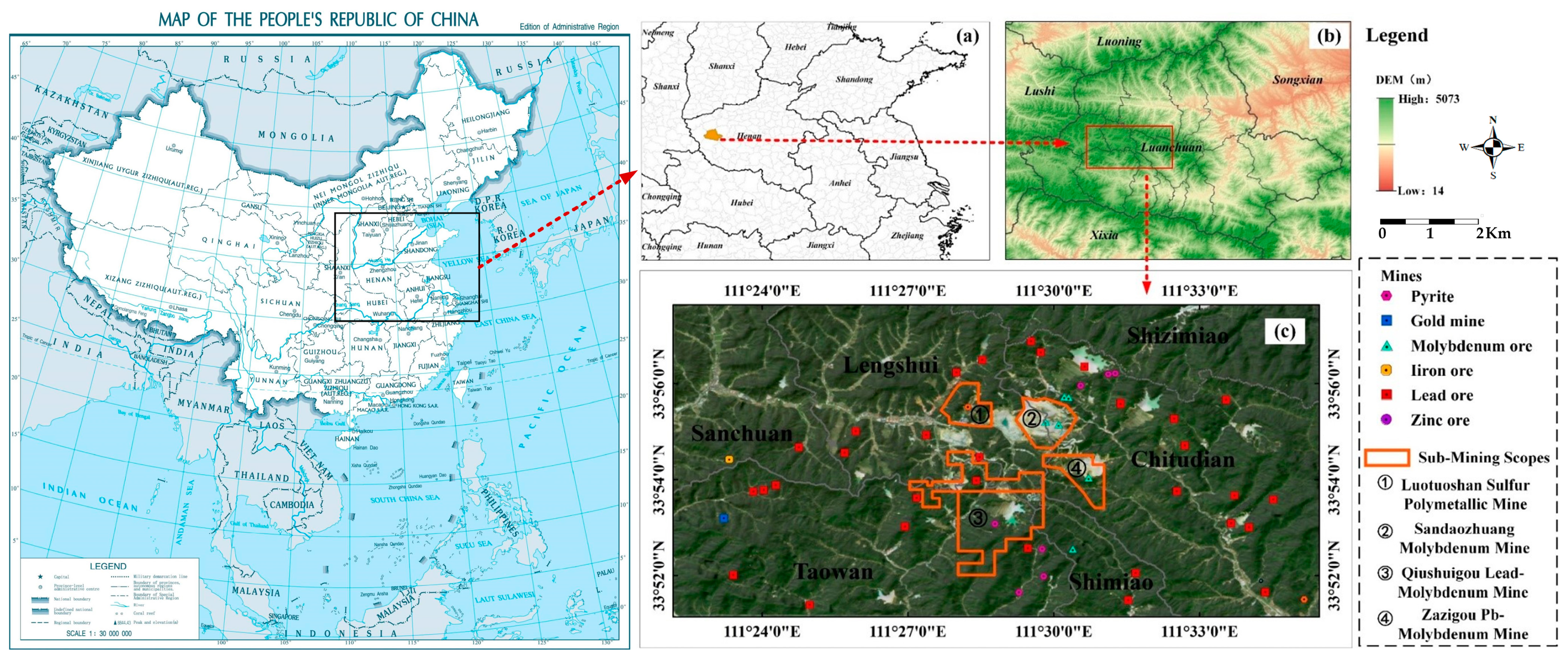
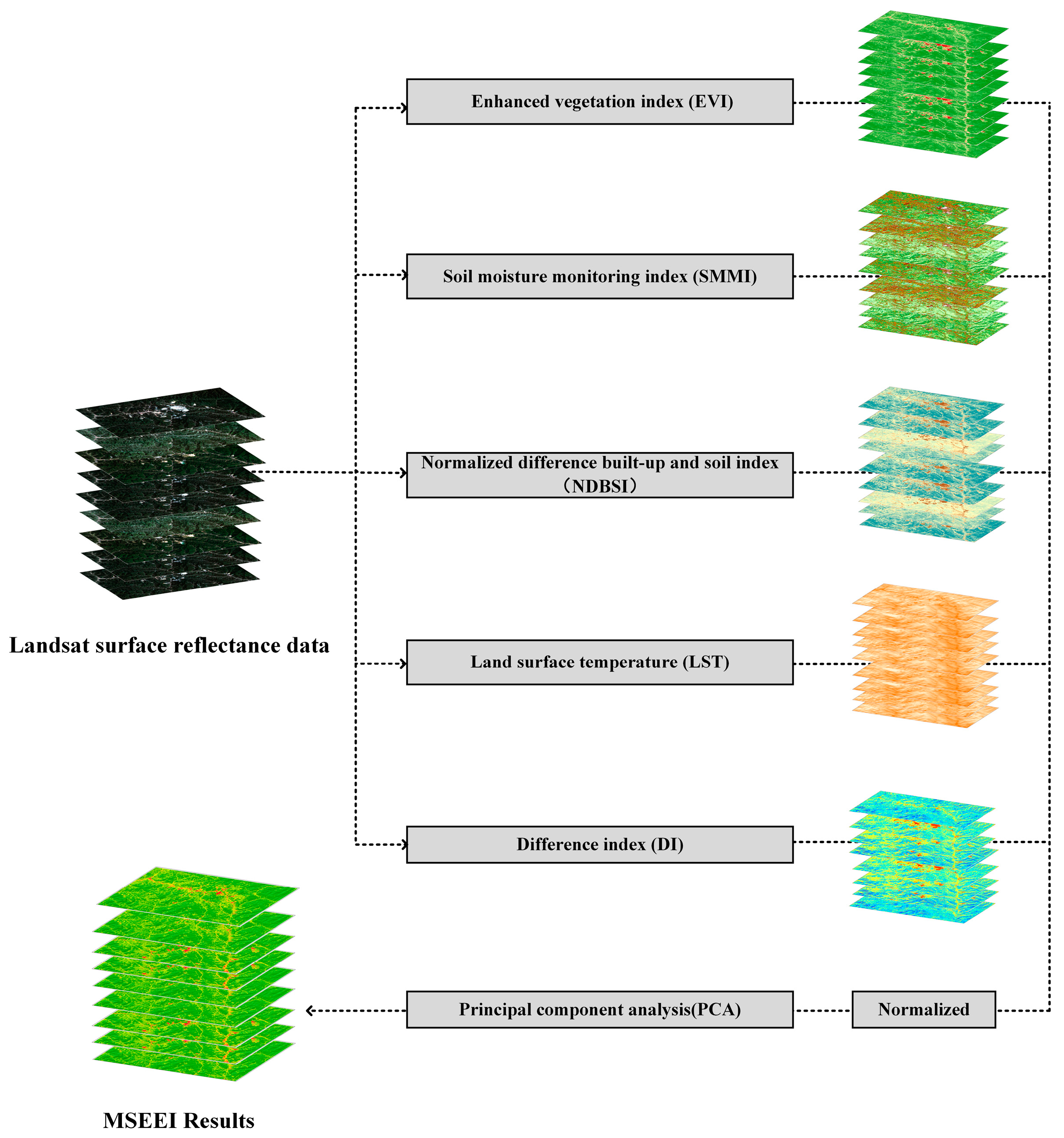
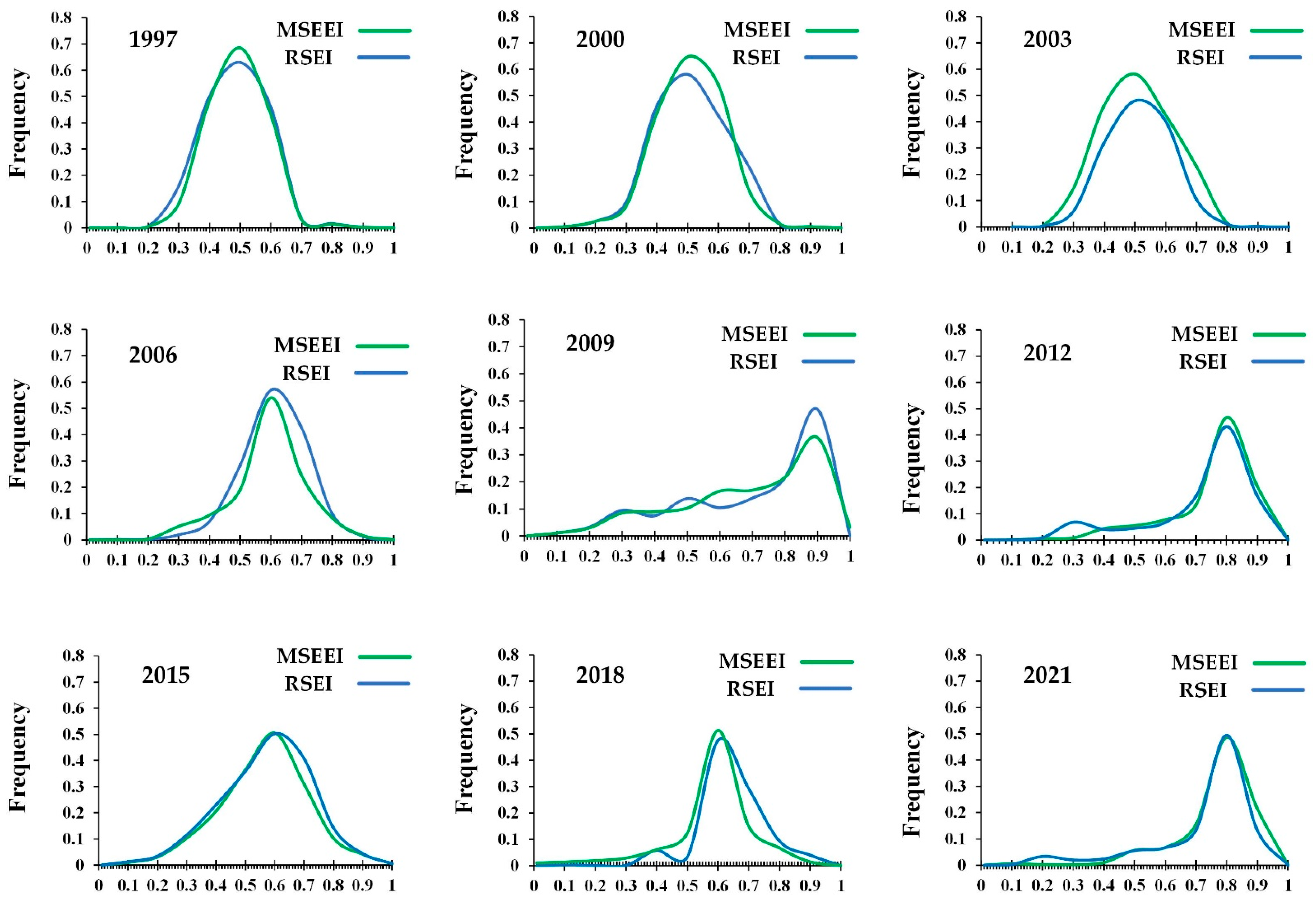
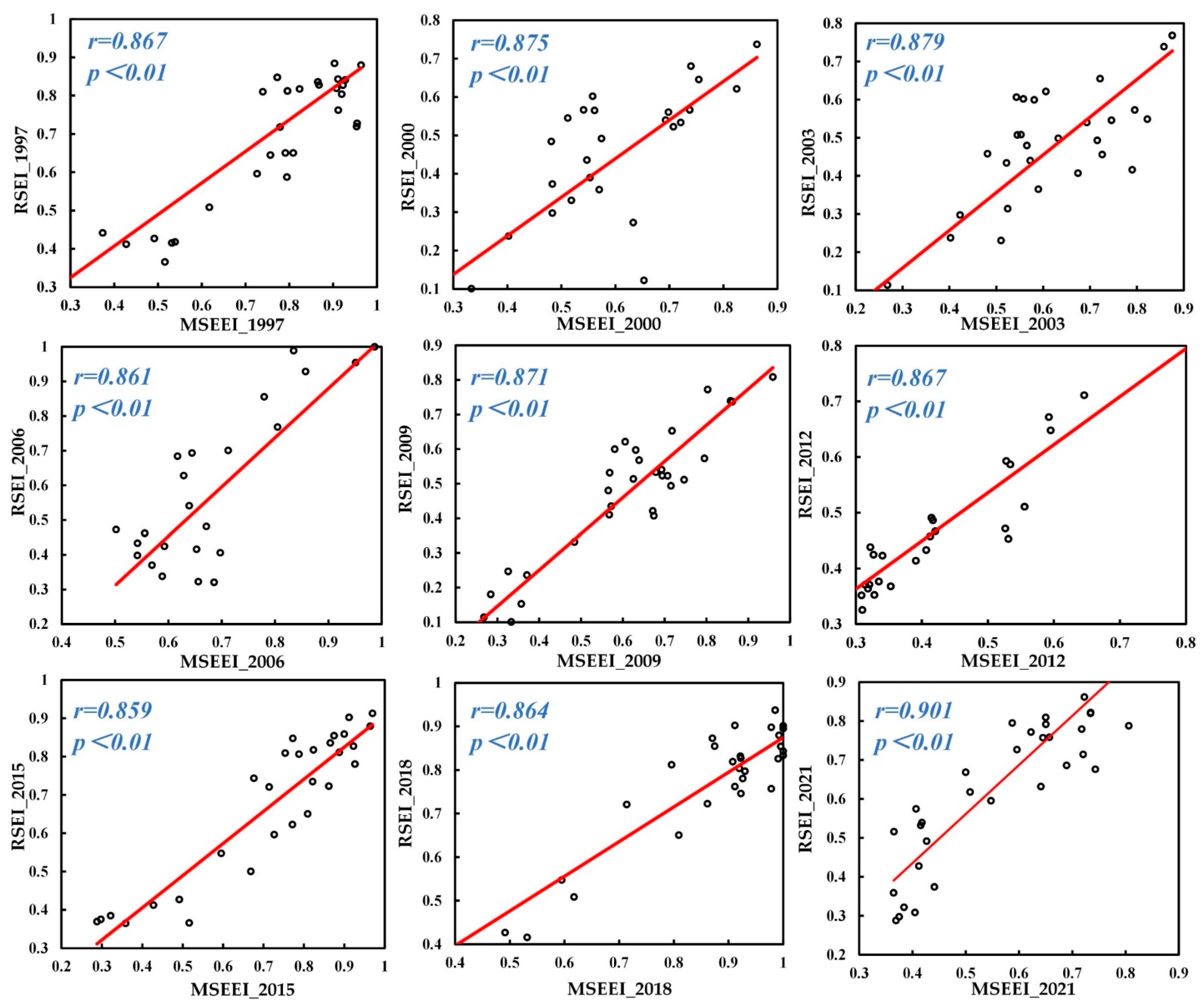
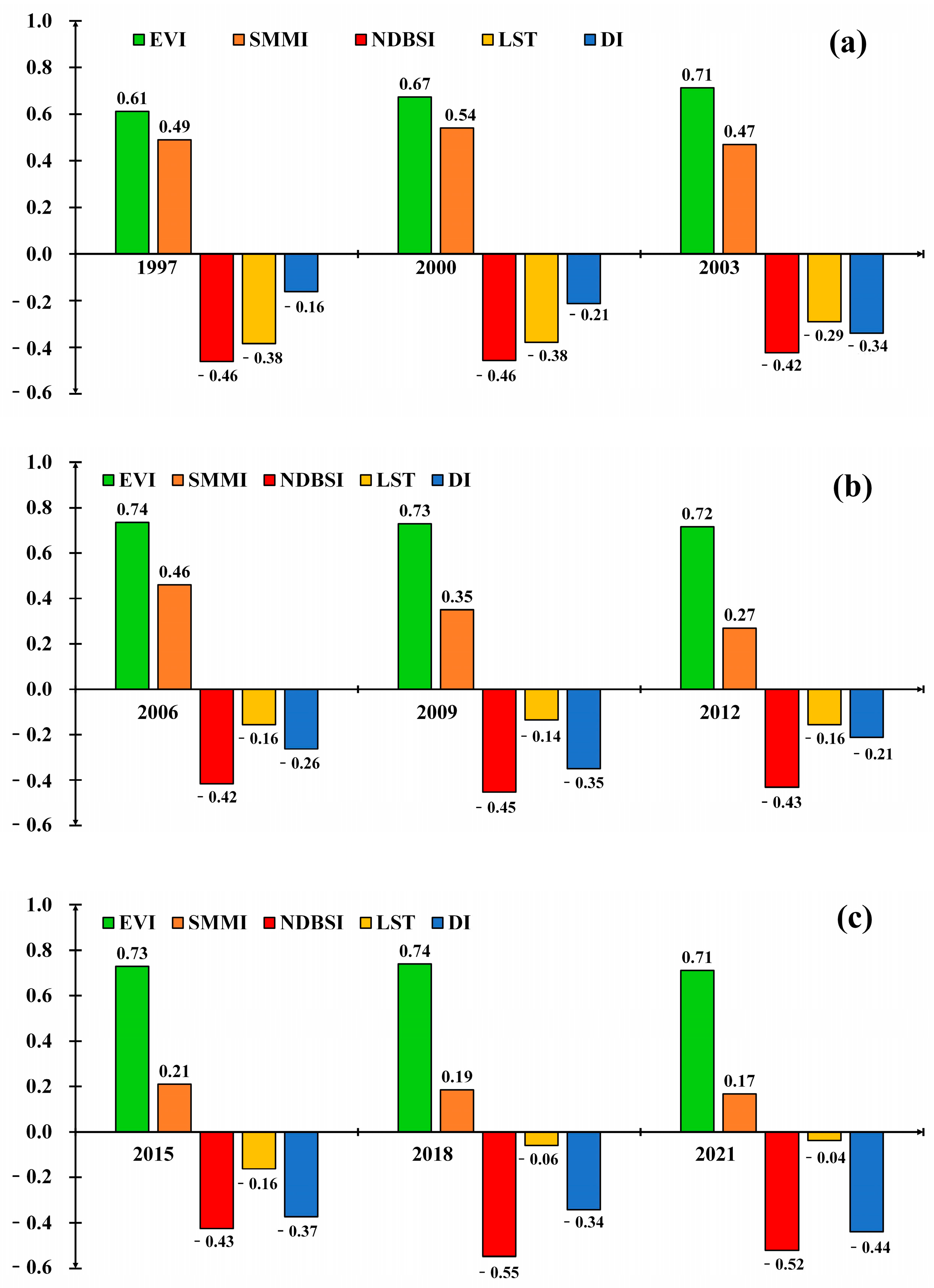
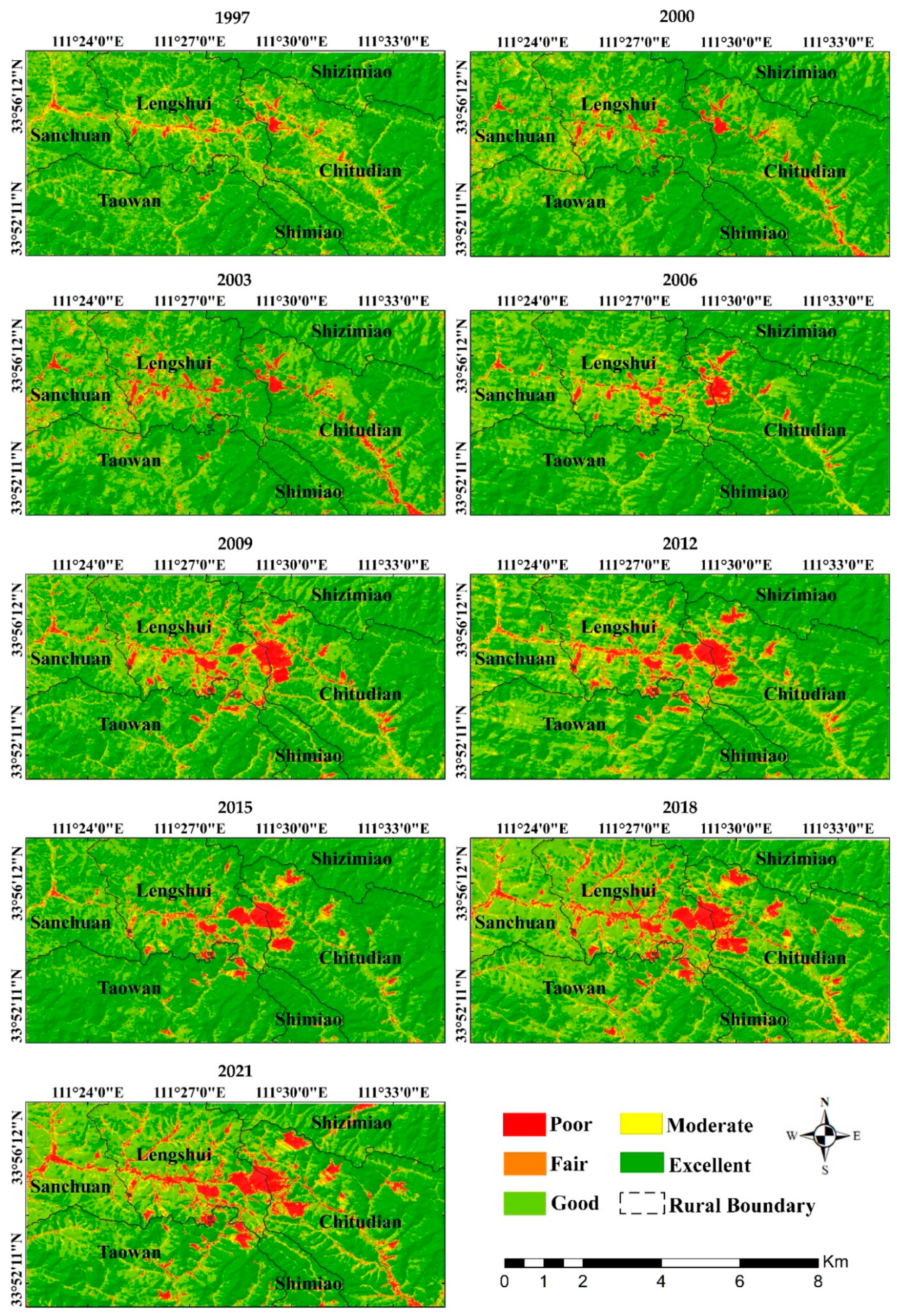
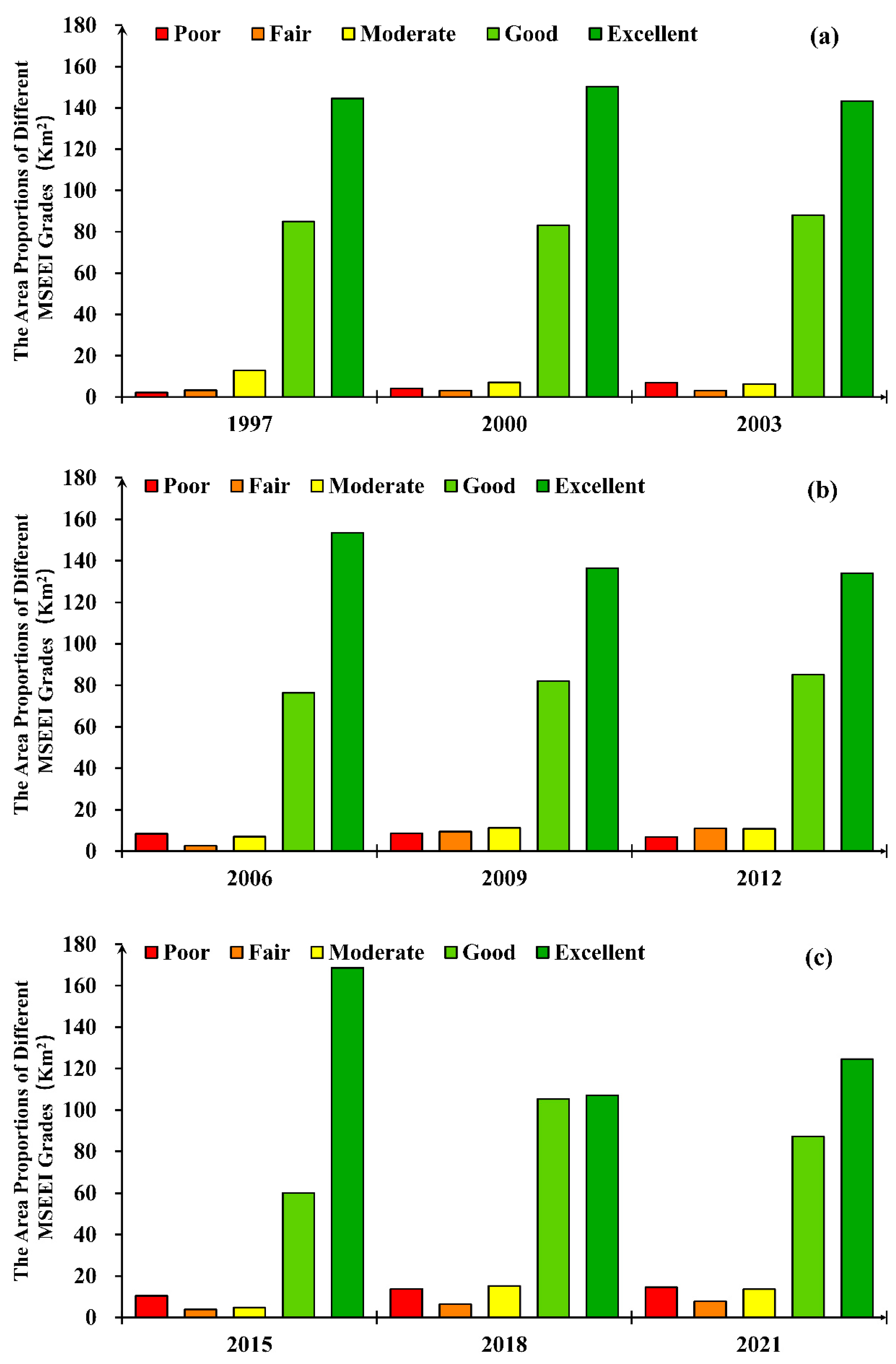
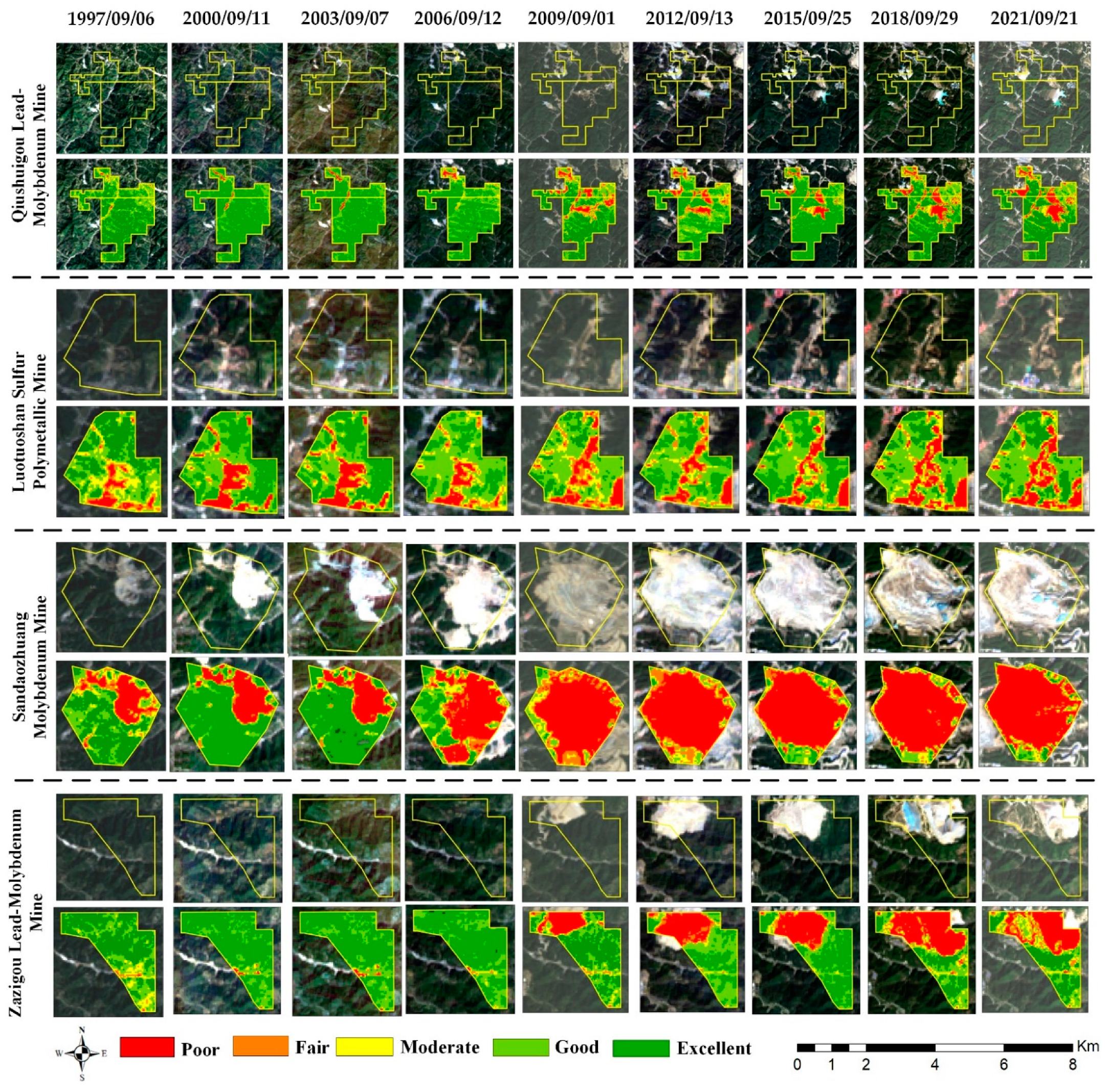
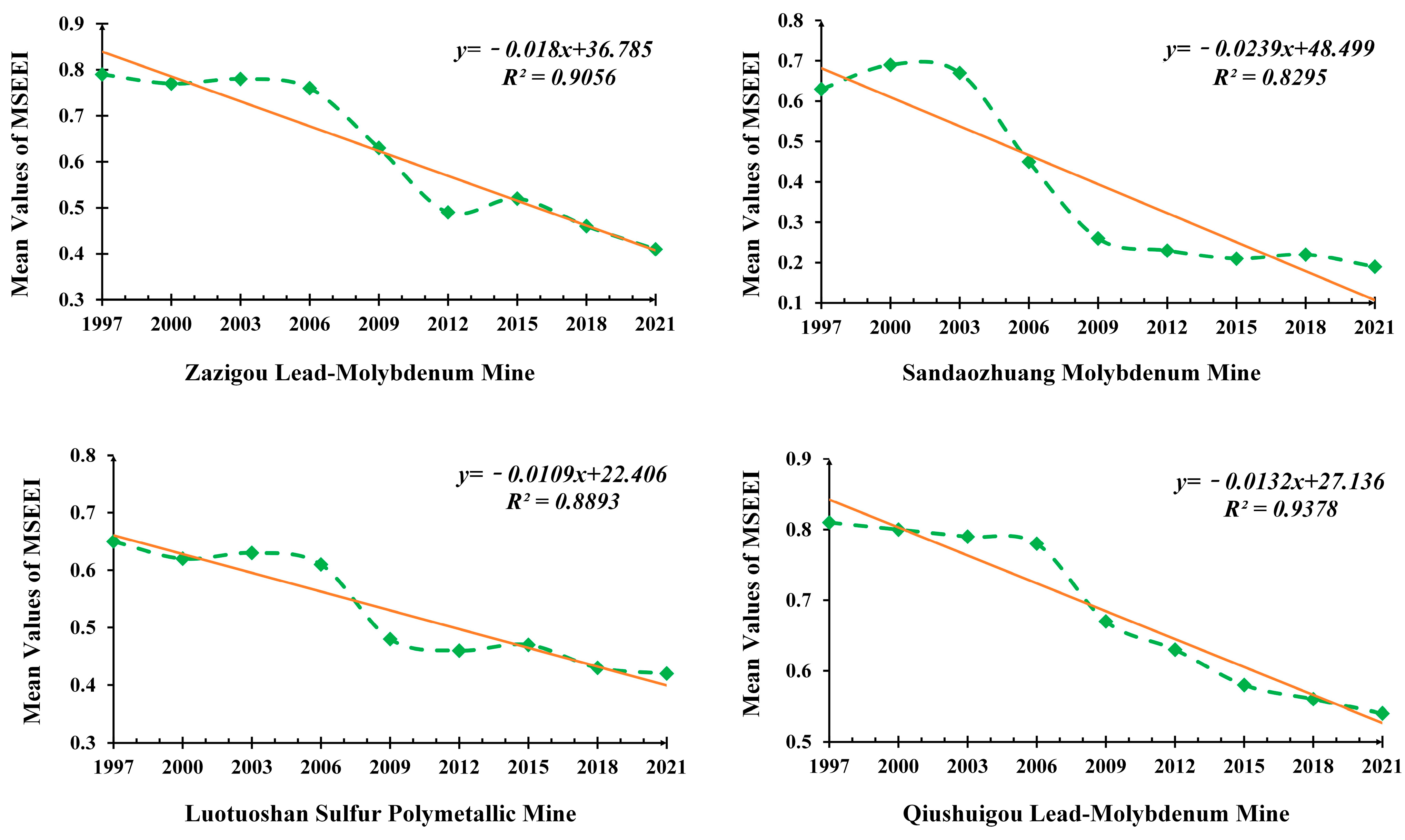
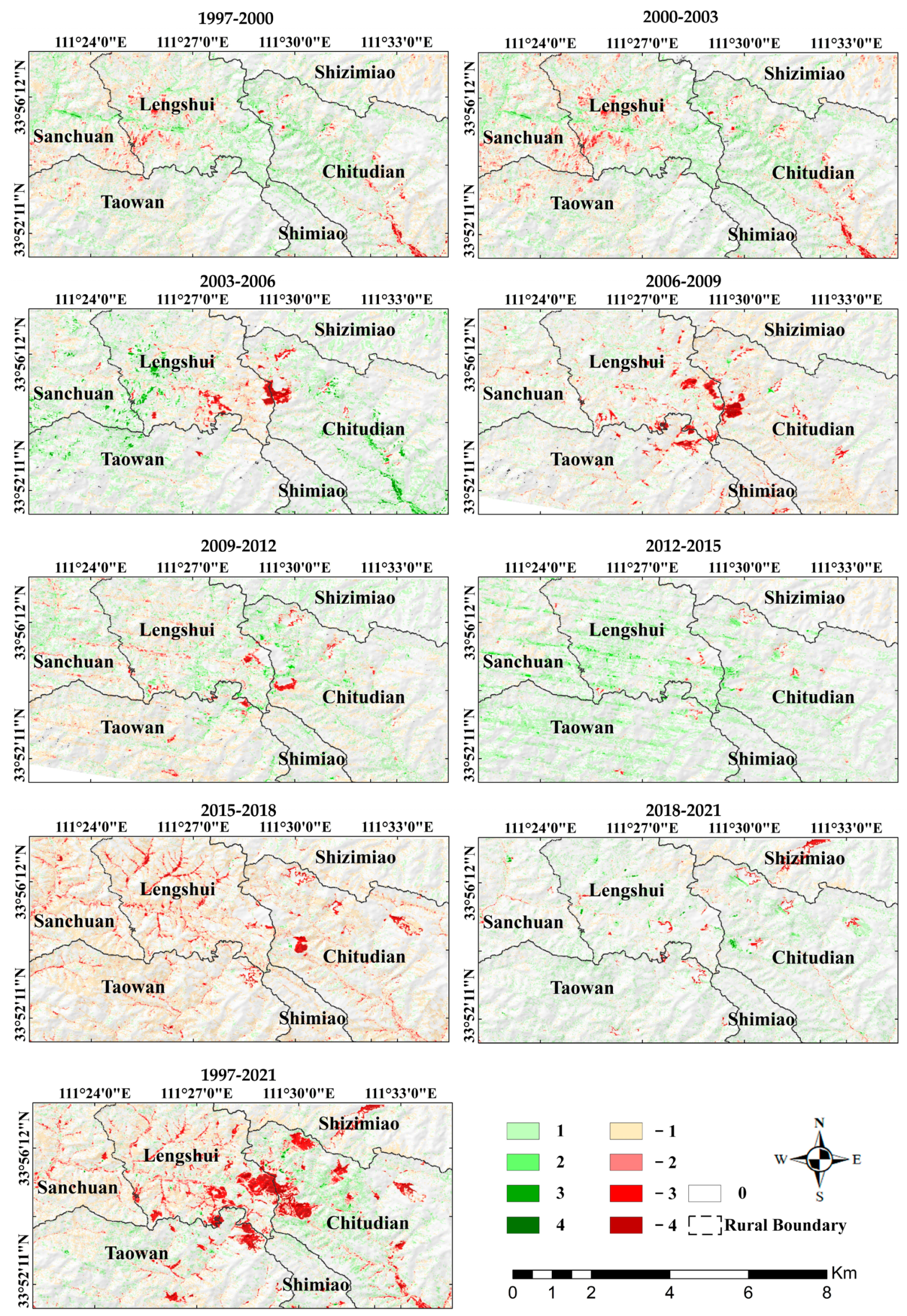
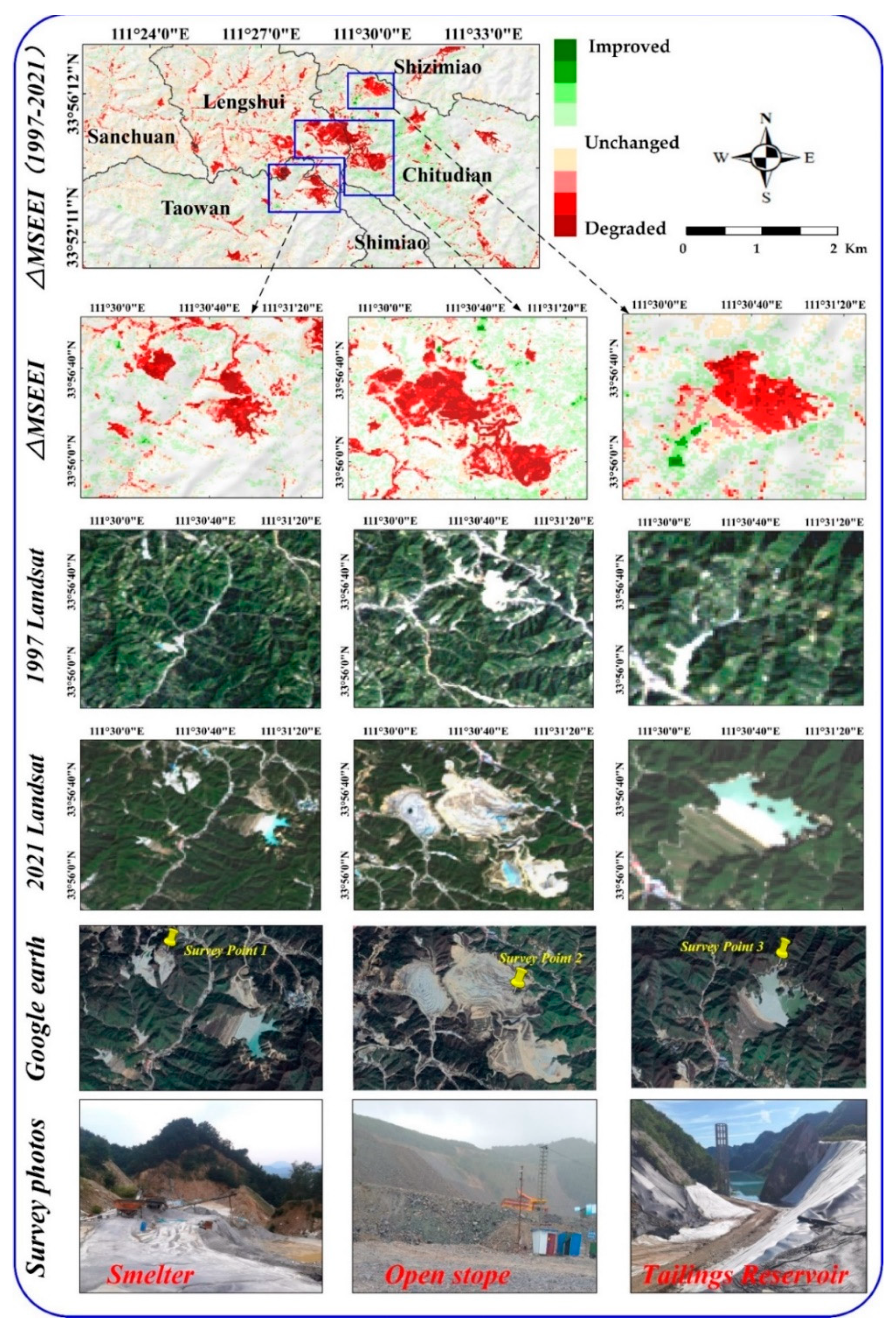
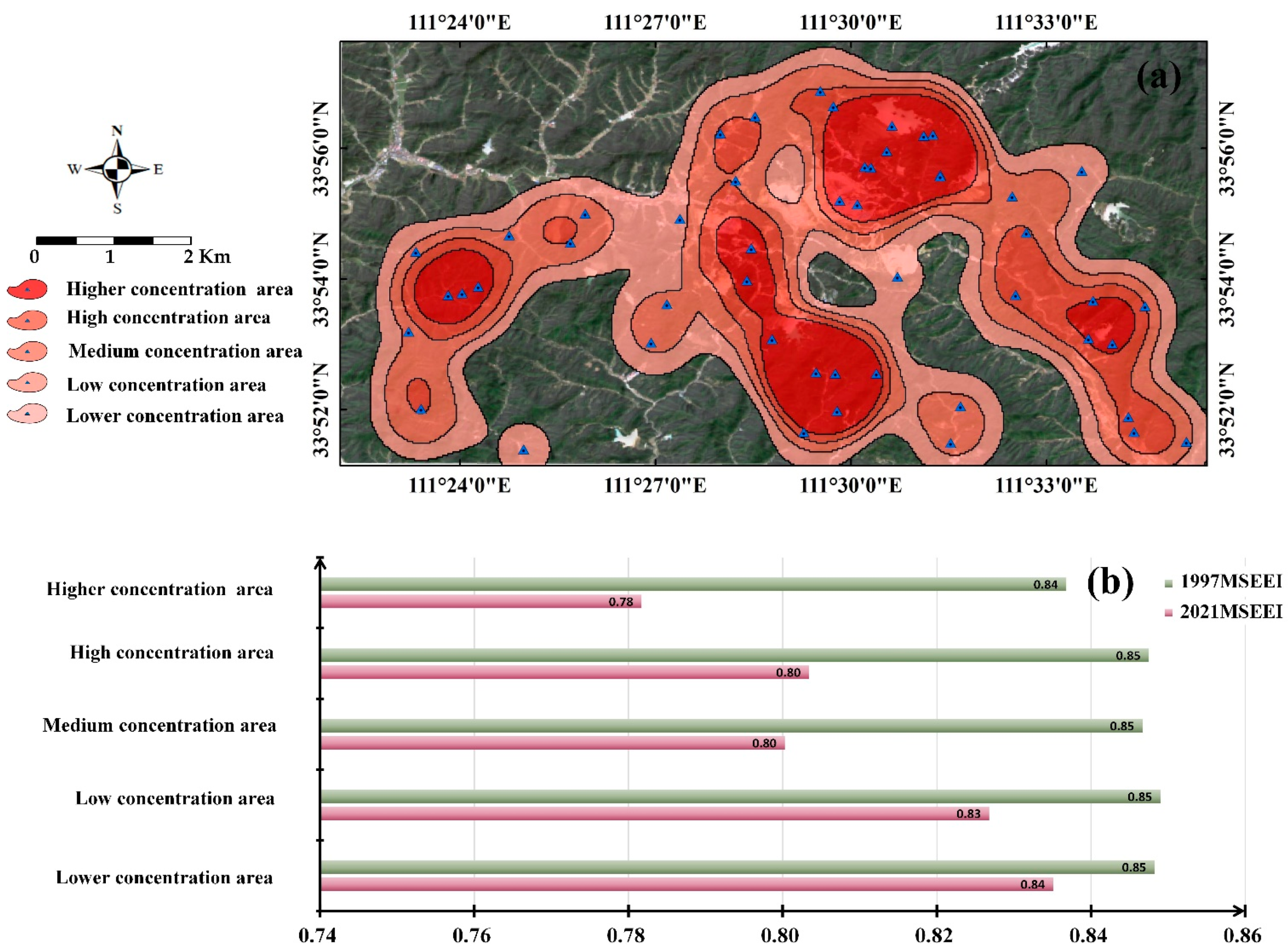
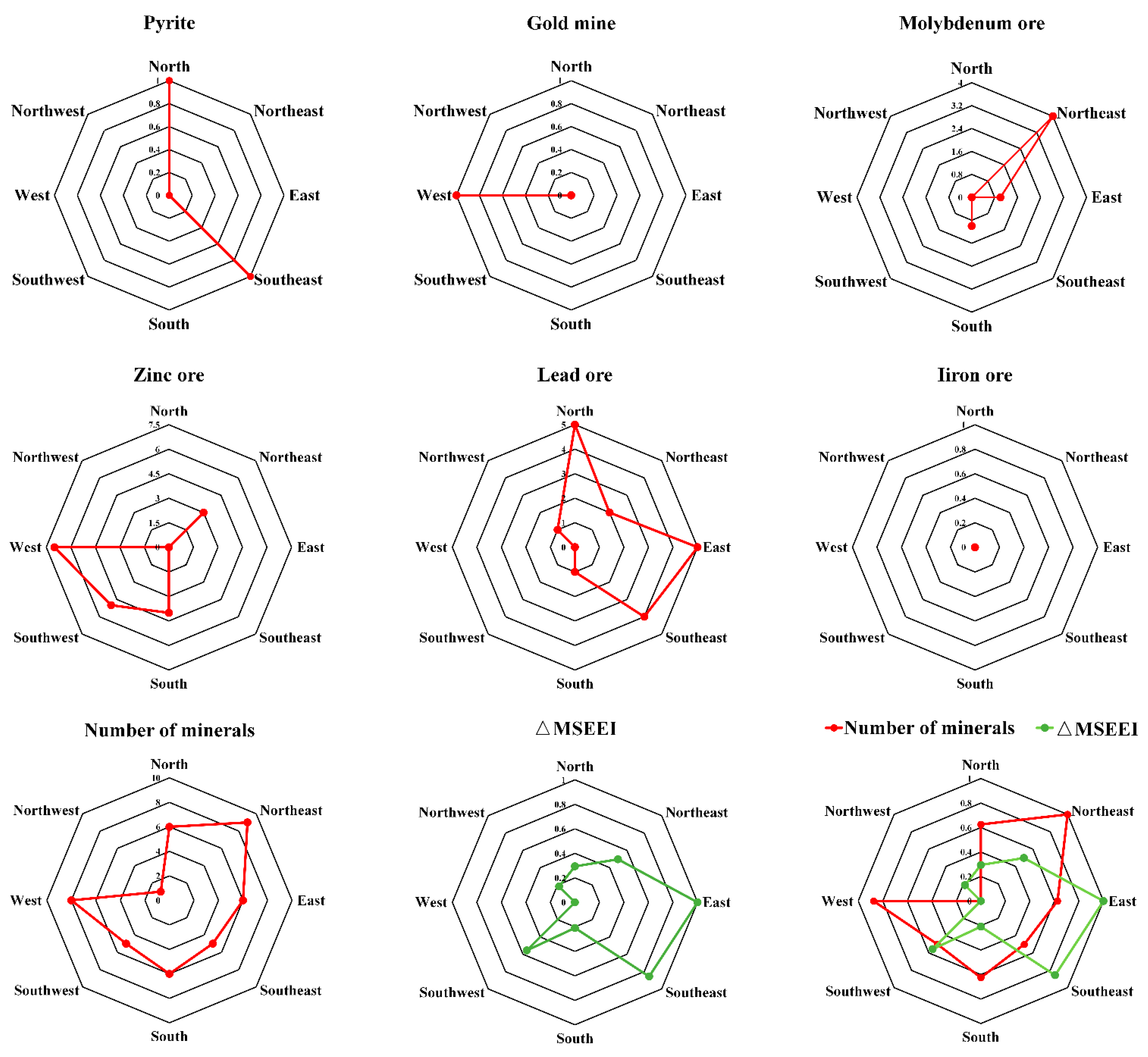
| Year | Mean Correlation of MSEEI and Indicators | |||||
|---|---|---|---|---|---|---|
| EVI | SMMI | NDBSI | DI | LST | MSEEI | |
| 1997 | 0.916 | 0.852 | 0.919 | 0.853 | 0.781 | 0.942 |
| 2000 | 0.879 | 0.863 | 0.861 | 0.793 | 0.785 | 0.872 |
| 2003 | 0.831 | 0.824 | 0.856 | 0.879 | 0.793 | 0.892 |
| 2006 | 0.865 | 0.873 | 0.773 | 0.756 | 0.871 | 0.915 |
| 2009 | 0.887 | 0.794 | 0.803 | 0.817 | 0.835 | 0.894 |
| 2012 | 0.871 | 0.789 | 0.779 | 0.834 | 0.791 | 0.968 |
| 2015 | 0.815 | 0.827 | 0.781 | 0.864 | 0.879 | 0.889 |
| 2018 | 0.836 | 0.831 | 0.892 | 0.867 | 0.872 | 0.897 |
| 2021 | 0.871 | 0.845 | 0.906 | 0.854 | 0.862 | 0.923 |
| Average | 0.863 | 0.833 | 0.841 | 0.835 | 0.830 | 0.910 |
| 1997 | 2000 | 2003 | 2006 | 2009 | 2012 | 2015 | 2018 | 2021 | |
|---|---|---|---|---|---|---|---|---|---|
| EVI | 0.76 | 0.73 | 0.75 | 0.71 | 0.69 | 0.70 | 0.67 | 0.68 | 0.67 |
| SMMI | 0.69 | 0.66 | 0.67 | 0.64 | 0.59 | 0.56 | 0.57 | 0.55 | 0.54 |
| NDBSI | 0.40 | 0.37 | 0.43 | 0.32 | 0.47 | 0.39 | 0.41 | 0.38 | 0.36 |
| DI | 0.46 | 0.41 | 0.36 | 0.37 | 0.42 | 0.33 | 0.35 | 0.31 | 0.38 |
| LST | 0.31 | 0.37 | 0.33 | 0.35 | 0.40 | 0.41 | 0.32 | 0.36 | 0.34 |
| MSEEI | 0.85 | 0.82 | 0.83 | 0.81 | 0.79 | 0.77 | 0.80 | 0.84 | 0.80 |
| Mining Scope | MSEEI in Each Grade Percentage (%) | |||||||||
|---|---|---|---|---|---|---|---|---|---|---|
| 1997 | 2000 | 2003 | 2006 | 2009 | 2012 | 2015 | 2018 | 2021 | ||
| Qiushuigou Lead-Molybdenum Mine (9.27 km2) | Poor | 0.29 | 0.88 | 1.35 | 1.31 | 2.39 | 6.74 | 6.04 | 10.79 | 12.82 |
| Fair | 0.64 | 0.48 | 0.36 | 0.95 | 2.90 | 6.39 | 3.27 | 3.96 | 4.25 | |
| Moderate | 4.68 | 0.65 | 0.54 | 2.90 | 4.02 | 6.42 | 3.90 | 7.61 | 7.29 | |
| Good | 30.08 | 18.12 | 18.26 | 27.16 | 28.53 | 36.70 | 17.51 | 33.41 | 25.39 | |
| Excellent | 64.30 | 79.87 | 79.49 | 67.67 | 62.16 | 43.75 | 69.27 | 44.23 | 50.26 | |
| Luotuoshan Sulfur Polymetallic Mine (1.83 km2) | Poor | 0.29 | 14.97 | 15.47 | 8.76 | 14.92 | 10.82 | 11.68 | 19.53 | 18.21 |
| Fair | 0.64 | 3.70 | 4.52 | 7.65 | 13.23 | 11.93 | 7.98 | 7.57 | 8.15 | |
| Moderate | 4.66 | 5.14 | 8.68 | 12.09 | 13.58 | 8.97 | 9.34 | 11.47 | 9.33 | |
| Good | 29.94 | 37.97 | 31.18 | 49.28 | 45.79 | 43.44 | 38.13 | 45.41 | 42.09 | |
| Excellent | 64.48 | 38.21 | 40.15 | 22.21 | 13.97 | 24.85 | 32.87 | 16.02 | 22.22 | |
| Sandaozhuang Molybdenum Mine (2.51 km2) | Poor | 18.49 | 21.58 | 22.20 | 47.13 | 69.91 | 72.99 | 73.05 | 79.62 | 78.21 |
| Fair | 7.29 | 2.53 | 3.14 | 11.11 | 14.14 | 12.66 | 6.51 | 4.88 | 5.67 | |
| Moderate | 9.40 | 2.73 | 3.90 | 9.48 | 7.23 | 6.89 | 4.90 | 6.53 | 5.49 | |
| Good | 25.63 | 11.05 | 8.74 | 15.75 | 7.48 | 6.81 | 10.91 | 7.47 | 7.29 | |
| Excellent | 39.20 | 62.11 | 62.02 | 16.52 | 1.24 | 0.65 | 4.64 | 1.51 | 3.34 | |
| Zazigou Lead-Molybdenum Mine (2.05 km2) | Poor | 0.27 | 0.68 | 1.01 | 0.14 | 15.56 | 26.24 | 27.54 | 43.64 | 31.26 |
| Fair | 1.33 | 0.40 | 0.36 | 0.54 | 3.56 | 6.62 | 4.07 | 4.94 | 8.94 | |
| Moderate | 8.23 | 1.08 | 1.04 | 1.52 | 5.56 | 3.20 | 3.35 | 7.78 | 12.67 | |
| Good | 31.57 | 22.71 | 25.88 | 22.92 | 27.57 | 36.39 | 19.51 | 23.22 | 20.81 | |
| Excellent | 58.60 | 75.13 | 71.71 | 74.87 | 47.75 | 27.54 | 45.54 | 20.42 | 26.32 | |
| ΔMSEEI | Degraded | Unchanged | Improved | |||||||
|---|---|---|---|---|---|---|---|---|---|---|
| −4 | −3 | −2 | −1 | 0 | 1 | 2 | 3 | 4 | ||
| 1997–2000 | Area (km2) | 0.28 | 1.17 | 3.54 | 27.81 | 167.69 | 43.45 | 3.58 | 0.30 | 0.01 |
| Percentage (%) | 0.11% | 0.47% | 1.43% | 11.22% | 67.66% | 17.53% | 1.44% | 0.12% | 0.00% | |
| 2000–2003 | Area (km2) | 0.30 | 1.49 | 5.84 | 35.74 | 158.25 | 43.46 | 2.47 | 0.26 | 0.01 |
| Percentage (%) | 0.12% | 0.60% | 2.36% | 14.42% | 63.85% | 17.54% | 1.00% | 0.11% | 0.00% | |
| 2003–2006 | Area (km2) | 5.17 | 1.19 | 1.69 | 22.62 | 169.18 | 41.68 | 3.97 | 2.22 | 0.11 |
| Percentage (%) | 2.09% | 0.48% | 0.68% | 9.13% | 68.26% | 16.82% | 1.60% | 0.90% | 0.04% | |
| 2006–2009 | Area (km2) | 1.62 | 4.55 | 4.32 | 40.29 | 176.98 | 19.83 | 0.18 | 0.05 | 0.00 |
| Percentage (%) | 0.65% | 1.84% | 1.74% | 16.26% | 71.41% | 8.00% | 0.07% | 0.02% | 0.00% | |
| 2009–2012 | Area (km2) | 0.26 | 0.96 | 3.41 | 37.41 | 161.75 | 37.70 | 3.90 | 2.27 | 0.16 |
| Percentage (%) | 0.10% | 0.39% | 1.38% | 15.10% | 65.27% | 15.21% | 1.57% | 0.92% | 0.07% | |
| 2012–2015 | Area (km2) | 0.01 | 0.23 | 0.49 | 16.32 | 174.07 | 51.75 | 4.46 | 0.49 | 0.00 |
| Percentage (%) | 0.00% | 0.09% | 0.20% | 6.58% | 70.24% | 20.88% | 1.80% | 0.20% | 0.00% | |
| 2015–2018 | Area (km2) | 0.91 | 2.57 | 8.43 | 77.88 | 151.08 | 6.86 | 0.08 | 0.01 | 0.00 |
| Percentage (%) | 0.37% | 1.04% | 3.40% | 31.42% | 60.96% | 2.77% | 0.03% | 0.01% | 0.00% | |
| 2018–2021 | Area (km2) | 0.31 | 0.98 | 1.57 | 14.66 | 195.86 | 33.23 | 0.97 | 0.23 | 0.02 |
| Percentage (%) | 0.12% | 0.40% | 0.63% | 5.91% | 79.03% | 13.41% | 0.39% | 0.09% | 0.01% | |
| 1997–2021 | Area (km2) | 4.36 | 6.57 | 8.93 | 45.24 | 151.38 | 29.63 | 1.52 | 0.17 | 0.02 |
| Percentage (%) | 1.76% | 2.65% | 3.60% | 18.26% | 61.08% | 11.96% | 0.61% | 0.07% | 0.01% | |
| Region | DEM (m) | Area Percentage of ΔMSEEI (%) | ||||||||
|---|---|---|---|---|---|---|---|---|---|---|
| −4 | −3 | −2 | −1 | 0 | 1 | 2 | 3 | 4 | ||
| Higher concentration area (15.33 km2) | 828~1099 | 0.06 | 0.25 | 0.55 | 1.38 | 3.61 | 1.07 | 0.06 | 0.02 | 0.00 |
| 1099~1283 | 0.58 | 0.53 | 0.48 | 3.00 | 14.13 | 4.43 | 0.24 | 0.01 | 0.00 | |
| 1283~1428 | 0.66 | 0.98 | 1.97 | 6.71 | 24.08 | 4.69 | 0.23 | 0.01 | 0.00 | |
| 1428~1685 | 0.38 | 0.60 | 0.64 | 6.68 | 19.34 | 2.54 | 0.08 | 0.00 | 0.00 | |
| High concentration area (11.93 km2) | 828~1099 | 0.34 | 0.55 | 0.73 | 1.33 | 4.81 | 1.69 | 0.12 | 0.02 | 0.00 |
| 1099~1283 | 0.21 | 0.37 | 0.57 | 2.18 | 12.69 | 3.82 | 0.32 | 0.04 | 0.00 | |
| 1283~1428 | 0.70 | 1.65 | 2.28 | 8.08 | 22.89 | 5.18 | 0.29 | 0.03 | 0.00 | |
| 1428~1685 | 0.48 | 0.57 | 0.51 | 5.58 | 18.16 | 3.63 | 0.16 | 0.02 | 0.00 | |
| Medium concentration area (24.86 km2) | 828~1099 | 0.12 | 0.32 | 0.71 | 2.06 | 7.76 | 2.65 | 0.17 | 0.03 | 0.00 |
| 1099~1283 | 0.04 | 0.30 | 0.49 | 1.82 | 11.06 | 3.03 | 0.20 | 0.01 | 0.00 | |
| 1283~1428 | 1.71 | 2.35 | 2.46 | 8.32 | 19.85 | 4.21 | 0.32 | 0.03 | 0.00 | |
| 1428~1685 | 2.49 | 1.97 | 0.86 | 6.33 | 15.24 | 2.95 | 0.14 | 0.00 | 0.00 | |
| Low concentration area (42.28 km2) | 828~1099 | 0.53 | 0.62 | 0.60 | 1.39 | 3.27 | 1.17 | 0.03 | 0.00 | 0.00 |
| 1099~1283 | 0.47 | 0.68 | 0.96 | 2.93 | 10.71 | 3.51 | 0.13 | 0.00 | 0.00 | |
| 1283~1428 | 1.84 | 3.26 | 2.25 | 6.28 | 19.35 | 4.12 | 0.20 | 0.06 | 0.04 | |
| 1428~1685 | 2.87 | 2.29 | 1.33 | 6.77 | 19.19 | 3.05 | 0.11 | 0.00 | 0.00 | |
| Lower concentration area (45.74 km2) | 828~1099 | 0.00 | 0.00 | 0.00 | 0.00 | 0.00 | 0.00 | 0.00 | 0.00 | 0.00 |
| 1099~1283 | 0.15 | 0.37 | 0.84 | 2.30 | 8.46 | 4.11 | 0.60 | 0.14 | 0.05 | |
| 1283~1428 | 1.40 | 3.77 | 2.55 | 5.99 | 21.51 | 5.41 | 0.60 | 0.29 | 0.05 | |
| 1428~1685 | 0.67 | 0.89 | 0.82 | 3.05 | 30.48 | 5.29 | 0.22 | 0.00 | 0.00 | |
| Direction | North | Northeast | East | Southeast | South | Southwest | West | Northwest |
|---|---|---|---|---|---|---|---|---|
| Pyrite | 1 | 0 | 0 | 1 | 0 | 0 | 0 | 0 |
| Gold mine | 0 | 0 | 0 | 0 | 0 | 0 | 1 | 0 |
| Molybdenum ore | 0 | 4 | 1 | 0 | 1 | 0 | 0 | 0 |
| Iron ore | 0 | 0 | 0 | 0 | 0 | 0 | 0 | 0 |
| Lead ore | 5 | 2 | 5 | 4 | 1 | 0 | 0 | 1 |
| Zinc ore | 0 | 3 | 0 | 0 | 4 | 5 | 7 | 0 |
| Total | 6 | 9 | 6 | 5 | 6 | 5 | 8 | 1 |
| Change Value | 0.013 | 0.016 | 0.024 | 0.021 | 0.011 | 0.017 | 0.008 | 0.011 |
Disclaimer/Publisher’s Note: The statements, opinions and data contained in all publications are solely those of the individual author(s) and contributor(s) and not of MDPI and/or the editor(s). MDPI and/or the editor(s) disclaim responsibility for any injury to people or property resulting from any ideas, methods, instructions or products referred to in the content. |
© 2023 by the authors. Licensee MDPI, Basel, Switzerland. This article is an open access article distributed under the terms and conditions of the Creative Commons Attribution (CC BY) license (https://creativecommons.org/licenses/by/4.0/).
Share and Cite
Zhang, P.; Chen, X.; Ren, Y.; Lu, S.; Song, D.; Wang, Y. A Novel Mine-Specific Eco-Environment Index (MSEEI) for Mine Ecological Environment Monitoring Using Landsat Imagery. Remote Sens. 2023, 15, 933. https://doi.org/10.3390/rs15040933
Zhang P, Chen X, Ren Y, Lu S, Song D, Wang Y. A Novel Mine-Specific Eco-Environment Index (MSEEI) for Mine Ecological Environment Monitoring Using Landsat Imagery. Remote Sensing. 2023; 15(4):933. https://doi.org/10.3390/rs15040933
Chicago/Turabian StyleZhang, Peipei, Xidong Chen, Yu Ren, Siqi Lu, Dongwei Song, and Yingle Wang. 2023. "A Novel Mine-Specific Eco-Environment Index (MSEEI) for Mine Ecological Environment Monitoring Using Landsat Imagery" Remote Sensing 15, no. 4: 933. https://doi.org/10.3390/rs15040933
APA StyleZhang, P., Chen, X., Ren, Y., Lu, S., Song, D., & Wang, Y. (2023). A Novel Mine-Specific Eco-Environment Index (MSEEI) for Mine Ecological Environment Monitoring Using Landsat Imagery. Remote Sensing, 15(4), 933. https://doi.org/10.3390/rs15040933







